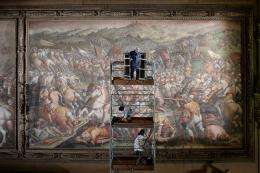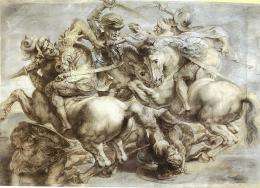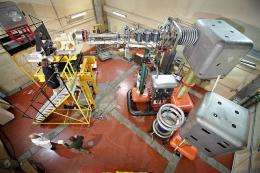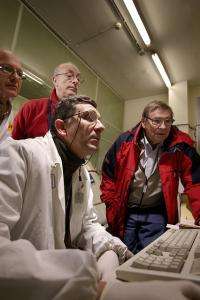Argonne scientist energizes quest for lost Leonardo da Vinci painting

Perhaps one of Leonardo da Vinci's greatest paintings has never been reprinted in books of his art. Known as the "Battle of Anghiari," it was abandoned and then lost—until a determined Italian engineer gave the art world hope that it still existed, and a physicist from the U.S. Department of Energy's Argonne National Laboratory developed a technique that may reveal it to the world once again.
The story starts in 1503 in the newly constructed "Hall of 500" of the Palazzo Vecchio, the town hall of Florence, Italy, where the city had called the geniuses Leonardo da Vinci and Michelangelo to each paint one wall. Leonardo chose to paint the Battle of Anghiari, and his sketches promised a marvel of motion and color worthy of his best work.
Leonardo worked out the sketches while his assistants covered the stone wall with a coating to even out the surface and seal out moisture, probably a combination of gypsum and rosin. Next came a layer of cheap white paint, most likely a compound called "tin white" containing tin and linseed oil. Then the assistants would have taken his enormous sketch and transferred the outlines onto the wall.
Faced with a wall this large, most other painters of the day would have used the fresco technique: applying watercolor paints to wet plaster, which dries in a few hours. Leonardo, however, wanted to experiment with oil paints, which allow for greater control, brightness and layering of color—but dry painfully slowly.
He began painting, slowly, the layers most likely taking weeks to dry. But something went wrong. Accounts vary, some saying the paint didn't adhere well enough, others that the mixture was too thick and began to drip down the walls—or even that he tried to dry one section with charcoal braziers that melted the paint. Leonardo was called back to Rome for another project and abandoned the painting in 1505.

It sat half-finished for decades. Other artists flocked to the spot to study the marvelous painting; Rafael and Ruben, among others, made copies based on the drawing and subsequent engravings, which are the only images of the painting that survive.
Then the hall was remodeled in 1563, and fresco painter Giorgio Vasari was commissioned to cover the walls in frescoes. To do so, he had to paint over Leonardo's work.
Fast-forward 400 years, during which Vasari's frescoes became famous in their own right and art scholars labeled Leonardo's original work "lost." Until Maurizio Seracini, engineer and Leonardo enthusiast, stood in the hall in 1975 and noticed a tiny painted flag in Vasari's intricate battle scene with the message "CERCA TROVA."
Seek and ye shall find.
Seracini speculated that the fresco painter might have constructed a brick second wall for his own work, leaving a few centimeters of space for Leonardo's sketch hidden beneath. At the time, however, technology did not permit exhaustive analysis. It wasn't until 2000 when Seracini returned, armed with laser and radar techniques, and confirmed the existence of a second wall.
Sonar, infrared and radar can find hidden architecture, but they didn't have the resolution to detect layers as thin as paint. Thus, Seracini had a problem. Since the Vasari fresco above it is also historic, the Italian government permitted Seracini to look for the painting but not to touch the wall itself. He needed a noninvasive way to detect the painting.

Along the way, photographer Dave Yoder had picked up an interest in the project. Reading about imaging from a distance, he came across a paper by Argonne physicist Robert Smither, who had designed a crystal lens to look inside the human body without damaging it—why not a brick wall?
Smither suggested a method using neutrons as a "camera" to detect the existence of the painting. In this approach, a small generator would shoot beams of energetic neutrons at the wall where the painting might be hidden. Some neutrons would pass through the frescoes and brick wall and strike the layers of Leonardo's paint below. The neutrons would react with the metals in the oil paints, producing radioactive nuclei that emit characteristic gamma rays. Some of these gamma rays would pass back through the brick wall, where Smither would measure them with a detector.
"What we'd do is look for specific kinds of radioactivity produced by different color paints," Smither said.
Chemicals used for oil paint colors contain unique isotopes. For example, red paint would contain mercury sulfide, and the gamma rays coming from mercury sulfide have a specific energy and decay rate, which the detector can measure.
"We think it should be possible to detect whether paint from the original painting survives, and perhaps even map an outline of the painting based on the colors," Smither said.

If no paint is detected, Smither says, the sadder alternative will be to beam the neutrons along the bottom of the opening to see whether Leonardo's paint flaked off the wall and collected at the bottom of the gap between the walls. (Half a century of weather—especially humidity—can devastate unprotected paintings, even those hidden behind brick walls.)
Smither's preliminary tests have indicated that the gamma ray detector can indeed pick up signatures from paint from behind a brick wall. The hall itself presents its own challenges—the painting itself is 20 feet off the floor, and the neutron generator and gamma ray detectors will have to be raised on movable scaffolds.
If the necessary funding is raised, the lost painting could be found thanks to science—which Leonardo, of all painters, would probably appreciate most.
Provided by Argonne National Laboratory



















